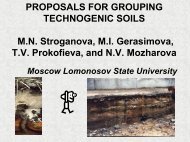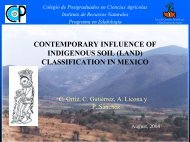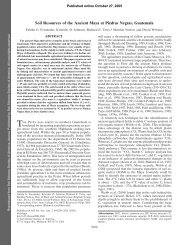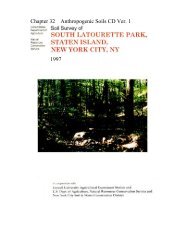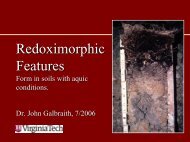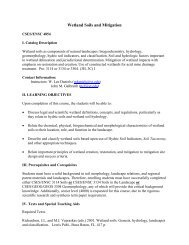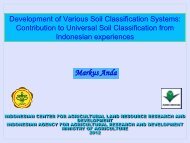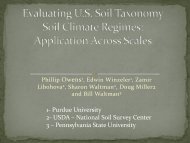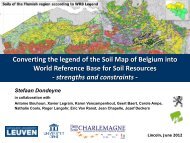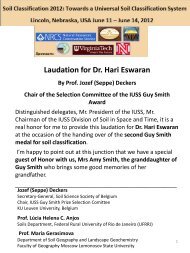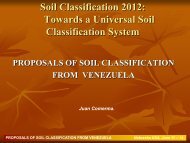Nebraska Soils Field Trip - Virginia Tech
Nebraska Soils Field Trip - Virginia Tech
Nebraska Soils Field Trip - Virginia Tech
Create successful ePaper yourself
Turn your PDF publications into a flip-book with our unique Google optimized e-Paper software.
Taxonomic Classifications of SND (12N0009)<br />
Soil Taxonomy<br />
KST, 11th ed. 2010 Fine-silty, mixed, superactive, nonacid, mesic Typic Udifluvents<br />
ICOMANTH (2-22-2012) Fine-silty, spolic, mixed, superactive, mesic Anthroportic Eutrudepts 3., 4.)<br />
WRB Haplic Cambisols (Humic, Hypereutric, Siltic, Escalic?, Transportic) 5., 6., 7.)<br />
1.)<br />
2.)<br />
3.)<br />
4.)<br />
Soil Survey Staff. 2010. Keys to Soil Taxonomy, 11th ed. USDA-Natural Resources Conservation Service, Washington, DC.<br />
IUSS Working Group WRB. 2007. World Reference Base for Soil Resources 2006, first update 2007. World Soil Resources Reports No.103. FAO, Rome.<br />
5.) Weighted average organic carbon content is 2 percent in upper 50 cm of soil (i.e., Humic qualifier).<br />
6.) Since new material is less than 50 cm thick, the buried soil is classified at the first level.<br />
7.)<br />
4th IUSS Soil Classification Conference <strong>Field</strong> Tour Guidebook<br />
Soil Survey Staff. 1999. Soil taxonomy: A basic system of soil classification for making and interpreting soil surveys. 2nd edition. Natural Resources Conservation Service.<br />
U.S. Department of Agriculture Handbook 436<br />
These horizons constitute the "surface mantle of new soil material" as defined for buried soils in Chapter 1 of Soil Taxonomy and the Keys to Soil Taxonomy. Their aggregate thickness (47 cm) is<br />
within the range of 30 to 50 cm and equals at least half of the total thickness (i.e., 36 cm × 0.5 = 18 cm) of the named diagnostic horizons that are preserved in the buried soil. The current<br />
classification (based on KST, 2010) reflects presence of a buried soil.<br />
The ICOMANTH classification reflects the presence of human-transported material (HTM) on a constructional anthropogenic landform (landfill) and less than 50 cm of HTM mantling the<br />
underlying genetic horizons (formed in an older deposit of HTM).<br />
Pedon would classify in either the methanogenic or subsidic class if the proposed control section for human-altered and human-transported material classes extended to 200 cm.<br />
Is the Escalic qualifier intended only for agricultural terraces?<br />
The Transportic qualifier was used alone without the Novic qualifier to avoid redundancy. Is the Novic qualifier intended for natural parent materials instead of human-made materials?<br />
118



